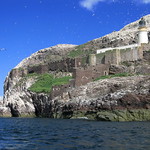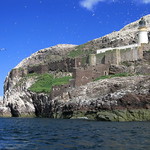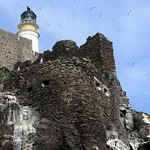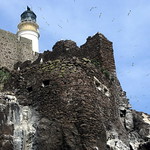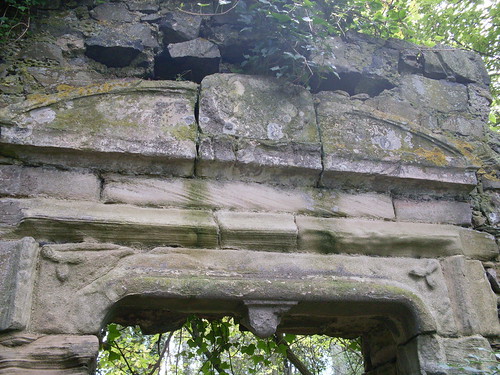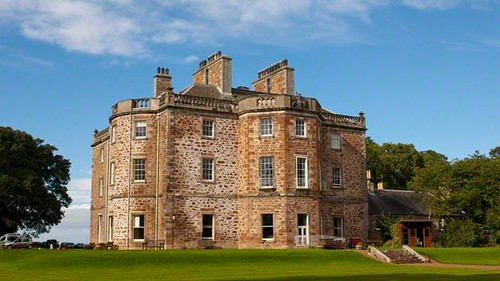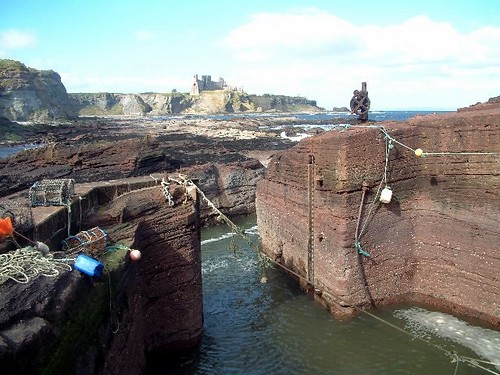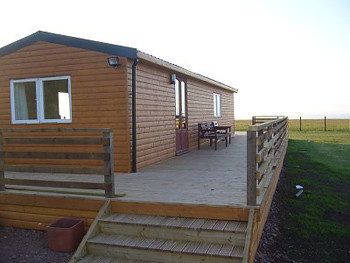Bass Rock Castle
Unoccupied volcanic rock in the Firth of Forth that is home to an important breeding colony of Gannets. Can be visited by boat trip.
Not far above the landing-place the slope is crossed by a curtain wall, which naturally follows the lie of the ground, having sundry projections and round bastions where a rocky projection offers a suitable foundation. The parapets are battlemented, with the usual walk along the top of the walls. Another curtain wall at right-angles runs down to the sea close to the landing-place, ending in a ruined round tower, whose vaulted base has poorly splayed and apparently rather unskillfully constructed embrasures. The entrance passes through this outwork wall close to where it joins the other.
The main defences are entered a little farther on in the same line, through a projecting two-story building which has some fireplaces with very simple and late mouldings. The buildings are of the local basalt, and the masonry is rough rubble; there are, as is so frequently the case, no very clear indications for dating the different parts, which were in all probability erected at different times.
A little beyond the entrance there is a tower that formed a simple bastion and to which has been added a gabled chamber in the 17th century, which, though of restricted dimensions, must have been comfortable enough, with blue Dutch tiles round its moulded fireplace, now very much decayed.
Famous prisoners
During the 15th century James I consigned several of his political enemies, including Walter Stewart[14] to The Bass. In this period, many members of the Clan MacKay ended up here, including, Neil Bhass MacKay (Niall "Bhas" MacAoidh), who gained his epithet from being imprisoned there as a fourteen year old in 1428. He was kept there as a hostage, after his father, Aonghas Dubh (Angus Dhu) of Strathnaver in Sutherland was released, as security.
After almost 600 years, the Lauders lost The Bass during Cromwell's invasion, and the castle subsequently (in 1671) became a notorious gaol to which for many decades religious and political prisoners, especially Covenanters such as Prophet Peden, were sent. John Blackadder, one of the Covenanting martyrs, died on the Bass in 1686 and is buried at North Berwick, where a United Free Church was named after him.
Charles Maitland, 3rd Earl of Lauderdale held the Bass for James VII for a brief period after the Scottish parliament declared his abdication. The fortress was destroyed by the government in 1701, and on 31st July 1706 the President of the Court of Session, Lord Dalrymple, acquired The Bass by charter (ratified by Parliament in March 1707), for a purely nominal sum, and the island has been ever since in the uninterrupted possession of the Dalrymple family.[15]
Listing Report on Bass Rock castle
Bass Castle: Access to the Bass Rock is by a landing at the SW corner and the long screen wall of the castle, on average 40ft in height, occupy a terrace above this landing, cutting it off from the remainder of the rock. A battlemented wall projects at right angles from the screen wall (see plan); this has an internal stair with gun ports covering the approach, and ends at the rock edge with a round battery whose ports command the landing place. (This battery is named the Crane Bastion on a plan of about 1700, the crane, used for raising supplies to the castle, being indicated a short distance away). At the N end, a gateway leads past a bastion to a projection in the main screen where an entrance gives access to a long stair. On the S side are the remains of a turnpike stair to the wall-head, and on the N, a single range of rooms. The screen wall continues, incorporating a little room known as Blackadder's Lodging (John Blackadder, minister of Traquair, was one of the Covenanters imprisoned here in the late 17th century), till its final bastion merges into the cliff. Underneath Blackadder's room is a well chamber.
This work is built of local stone, with occasional dressings of imported freestone, and it is dated by the RCAHMS to the 16th century (though an earlier 'Castell of the Bas' is mentioned in 1405). At that time (i.e. 16th century) it belonged to the Lauders of Bass, passing to the Crown in 1671 and to Sir Hew Dalrymple of North Berwick in 1706. In 1902 the E part of the screen wall was pointed and given a flat-topped profile, and the lighthouse built above it (on the site of the governor's house).
RCAHMS 1924, visited 1920; C McWilliam 1978; J Reid 1886; Trans Roy Hist Soc 1895
The remains of the Castle are in good condition, the walls being approximately 4ft thick.
Visited by OS Reviser (DAD) 29 June 1952


